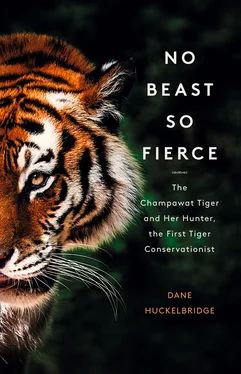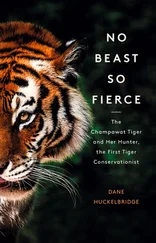The young man’s purpose is suddenly called into question. The notion of shooting the tiger before him feels impossibly bold, as if he were not killing a mere animal, but assassinating a king. Its body appears enormous, even from the safety of his machan. Its eyes are closer to those of a man than a pig or a deer, or any other creature he has encountered. And as if to further sour his conviction, two cubs appear, bounding almost playfully from the trees behind it. This is not just a tiger— she is a mother.
But for all his fear, the idea of returning home with nothing but the frayed goat tether unsettles him even more. No, he has made his decision. It must be done. And with the mother down, it will be easy to finish off the cubs as well. That’s two more tigers than he had bargained for. He takes the old muzzle-loader in his trembling hands, raises its battered stock to his shoulder, gets the tiger in his sights, and takes one final breath before pulling the trigger.
But that is enough. The rustle of his movements, however faint, are not missed by the tiger’s spotted ears. It drops the goat and raises its head in alarm, as a thunderclap bursts from the trees—a red sting of pain lashes at its jaw. The tiger rears back, as if to attack the air, only to find that its bite feels loose and unhinged. The taste of its own blood filling its throat, the tiger turns and streaks back into the forest, into the thick underbrush from whence it came, its two toy-sized cubs hesitating for a moment before bouncing along obediently behind.
The young man reloads his gun and springs down from his stand, racing to see if his bullet struck home. He notices the trampled earth beside the pathetic carcass of the goat, and next to it, a spattering of blood and two broken teeth—tiger teeth. The young man realizes his shot was poor and the tiger merely wounded, a fact that is confirmed moments later by a roar that seems to rend the very fabric of the air. He has heard tigers before, their low moaning from a distance, but this is different. He has never experienced anything like this. He feels the roar as much as hears it, in the pit of his stomach and the hollows of his chest. It is the purest distillation of rage he has ever known.
Darkness is coming. The idea of going blind into the bush to confront the enraged tiger is beyond comprehension to the young man, a nightmare he can’t even begin to consider. No, it would be suicide—courting death in its most primordial form. And so, still sick with adrenaline, he slings his antique gun over his shoulder and turns back to the village on weakened knees, first walking, then running, casting harried glances over his shoulder the whole way, covering his ears to stifle the roars. And while there is no way for this young man to know the full implications of what he has done, the terror he has unleashed, the lives he will have indirectly ruined, he must surely have an inkling, with those roars reverberating through the still air and damp leaves of the sal trees, that in the pulling of that trigger, he has created a monster.
INTRODUCTION
UNLIKELY HUNTERS
In the first decade of the twentieth century, the most prolific serial killer of human life the world has ever seen stalked the foothills of the Himalayas. A serial killer that was not merely content to kidnap victims at night and dismember their bodies, but also insisted on eating their flesh. A serial killer that, for the better part of ten years, eluded police, bounty hunters, assassins, and even an entire regiment of Nepalese Gurkhas.
A serial killer that happened to be a Royal Bengal tiger.
Specifically, a tiger known as the Man-Eater of Champawat. Far more than an apex predator that occasionally included humans in its diet, it was an animal that—for reasons that wouldn’t become apparent until its killing spree was over—explicitly regarded our species as a primary source of food. And to that end, this brazen Panthera tigris tigris hunted Homo sapiens on a regular basis across the rugged borderlands of Nepal and India in the early 1900s with shocking impunity and an almost supernatural efficacy. In the end, its reported tally added up to 436 human souls—more, some believe, than any other individual killer, man or animal, before or since.
Despite its unusual appetites and hunting prowess, however, surprisingly little has been written about the Champawat. And when the odd mention of the tiger does crop up, it is more often than not as a curious footnote to a broader article on human–tiger conflict, or as a gory bit of trivia from The Guinness Book of World Records . The fact that a single tiger was able to take such an immense human toll over such a long period of time is rarely presented as a subject worthy of historical scrutiny or academic study. It seems like a good story, and nothing more.
And admittedly, it is a fine story, and it is tempting to present it simply as such. It is universal in its appeal and almost literary in its Beowulfian dimensions: a man-eating creature that terrorizes the countryside, repeatedly evading capture, until a hero appears who is brave enough to track it straight to its lair. It is a timeless campfire tale, simple and hair-raising in the way all such yarns must be. Who wouldn’t want to hear a story like that? One that speaks to the most primal and deeply ingrained of all human fears?
But there is another story to be told here as well, and while certainly hair-raising, it is anything but simple. The events that transpired in the forests and valleys of the Himalayan foothills in the first decade of the twentieth century were not a series of bizarre aberrations. They were in fact the inevitable result of the tremendous cultural and ecological conflicts that were shaking the region—indeed, the world—at that time, affecting man and animal alike in unlikely ways, and throwing age-old systems chaotically out of whack. Far from some pulp fiction tale of man versus nature or good versus evil, the story of the Champawat is richer and much more complex, with protagonists at odds with even themselves.
Beginning, of course, with the actual tiger. Bengal tigers do not under normal circumstances kill or eat humans. They are by nature semi-nocturnal, deep-forest predators with a seemingly ingrained fear of all things bipedal; they are animals that will generally change direction at the first sign of a human rather than seek an aggressive confrontation. Yet at the turn of the twentieth century, a change so profound and upsetting to the natural order was occurring in Nepal and India as to cause one such tiger to not only lose its inborn fear of humans altogether, but to begin hunting them in their homes on an all but weekly basis—a tragedy for the more than four hundred individuals who would eventually fall victim to its teeth and claws. This tiger ceased to behave like a tiger at all, in important respects, and transformed into a new kind of creature all but unknown in the hills of northern India’s Kumaon district, prowling around villages and stalking men and women in broad daylight.
Then there is Jim Corbett, the now-legendary hunter who was finally commissioned by the British government to end the Champawat Tiger’s reign. To many, even in present-day India, he is nothing short of a secular saint, a brave and selfless figure who risked life and limb to defend poor villagers when no one else would. To others, particularly academics engaged with post-colonial ecologies, he is just another perpetrator of the Eurocentric paternalism that defined the colonial experience. Each is a fair judgment. The whole truth, however, is far more nuanced, as one would expect when it comes to a deeply conflicted man whose life spanned eras, generations, and eventually even empires. Jim Corbett was a prolific sportsman who, upon achieving fame, hobnobbed with aristocrats and used tiger hunts to curry their favor. But he was also a tireless advocate for wild tigers and devoted the latter part of his life to their conservation—as evidenced by the sprawling and magnificent national park in India that bears his name to this day. Yes, he did come to enjoy the trappings and privileges of the English sahib, servants and sport shooting and social clubs included. But as the domiciled son of an Irish postmaster, foreign-born and considered socially inferior, he was also keenly aware of what it meant to be colonized—by the very people he enabled and admired. And he did love India, above all its people, even while playing an unwitting part in the nation’s subjugation.
Читать дальше












